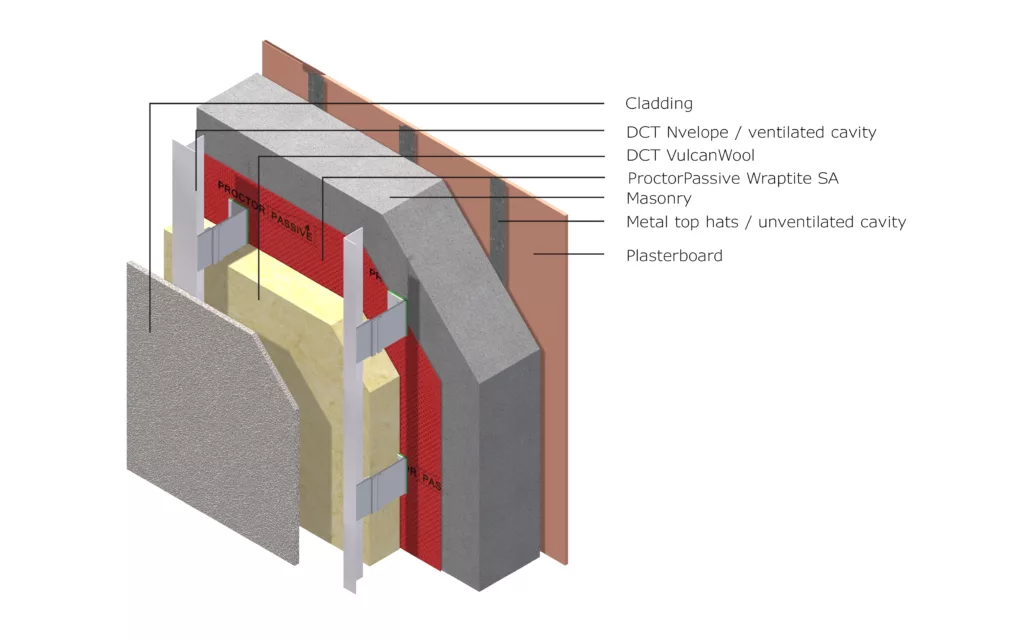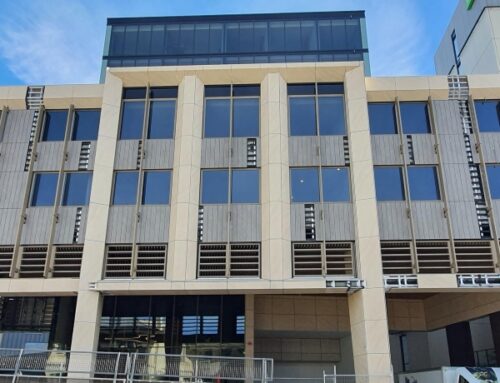Introduction
When something sounds too good to be true, it usually is. Since the NCC 2016 Amendment 1 clarified the requirement for all elements of type A and type B wall construction, including the insulation, to be non-combustible, DCTech have been receiving many enquiries about our market leading vacuum insulated panels (VIP).
Foil faced rigid foam board thermoset insulation such as PIR and phenolic insulation are deemed combustible and thus do not meet the non-combustibility requirement, creating demands for thin non-combustible insulation boards that also form an effective vapour barrier when installed to the interior of single skin masonry walls.
AS1530.1 and VIP vacuum insulation
Although the DCT VIP insulation is manufactured with a non-combustible core, a VIP cannot be tested to AS1530.1 because it is laminated product. See the extract below from AS1530.1:
AS 1530.1
1.4 APPLICATION TO FIRE HAZARD ASSESSMENT
The test results relate only to the behaviour of the test specimens of the material under the particular conditions of the test, and are not intended to be the sole criteria for assessing the potential fire hazard of the material in use.
The test method is not applicable to products which are coated, faced or laminated. In such cases, tests may be carried out separately on the individual materials from which the product is formed and this shall be clearly stated in the test report.
NOTE: The performance of coated, faced or laminated products may be determined by other reaction to fire tests.
Is there a Deemed to Satisfy (DTS) Pathway ?
The route for DTS compliance as a faced or laminated product would be with Part C1.9 (e) (vi) in NCC 2016 Amend. 1 or Part C1.9 (e) (vii) in NCC 2019.
NCC 2019 Volume 1
Part C1.9
(e) The following materials may be used wherever a non-combustible material is required:
(vii) Bonded laminated materials where—
(A) each lamina, including any core, is non-combustible; and
(B) each adhesive layer does not exceed 1 mm in thickness and the total thickness of the adhesive layers does not exceed 2 mm; and
(C) the Spread-of-Flame Index and the Smoke-Developed Index of the bonded laminated material as a whole do not exceed 0 and 3 respectively.

To create the vacuum in a VIP, the non combustible core needs to be wrapped and sealed in a durable vapour and air tight foil. To maintain the long term integrity of the film and thus the integrity and long term insulation performance of the vacuum the foil is faced with a polymer based protective film.
Furthermore to reduce the risk of the vacuum being punctured, the core is also wrapped with a soft polymer fleece.
Because of the need for these thin polymer combustible layers, The DCTech VIP panels will not meet the deemed to satisfy requirements of the NCC 2016 Amendment 1 or NCC 2019 requirements as a non-combustible material.
Other compliance pathways
The silica core of the VIP is an evacuated non-combustible board (Euroclass A1), but as a finished product including combustible protective layers, the VIP panels when tested to DIN 4102 / EN13501-1 are Class B2.
There are many buildings around Australia where combustible facades and insulation need to be replaced with non-combustible materials. Where space is limited, the DCTech VIP insulation offers in many cases the only chance to meet or exceed a minimum R-value requirement where foam insulation is being replaced. In such cases, a fire engineer may be willing on a project by project basis, to accept the VIP insulation as part of an performance (fire engineered) solution on the interior of a masonry wall because of the limited contribution to fire.
Other options for non-combustible insulation
At DCTech we also supply DCT VulcanWool which is tested to AS1530.1 and deemed to be non-combustible.
As a stone mineral fibre insulation, if installed on the interior of a masonry wall, without ventilation and drainage of condensate, this would pose a high condensation risk in cold and temperate climates.

DCT-W07-4 EXTERNALLY INSULATED MASONRY WALL (VULCANWOOL)
When using DCT Vulcanwool in masonry construction, the preference is clearly for exterior continuous insulation with a rainscreen such as DCT-W07-4 above.

DCT-W06-2 INTERNALLY INSULATED MASONRY WALL (VACUUM INSULATION PANEL)
VIP to the interior of single leaf concrete wall
When external insulation is not possible, such as in some renovation projects where space is limited and the value of the floor space is high, then It may worth discussing with your fire engineer if a DCT VIP insulation panel could be utilised as part of a performance solution for type A & type B construction.
What about roofs, ceilings, floors and type C walls?
The requirement for non-combustibility of insulation only applies for type A and type B walls and does not relate to roof, ceiling, floor and type C wall constructions where there are less stringent requirements.
Costs
The cost of VIP insulation is prohibitively high so is likely only to be considered where there lacks space to use other types of insulation such as the DCT VulcanWool or DCT PIR products. Being able to provide material R-value of R2.8 with just 20mm insulation does not come cheap. However, it is worth noting that the increase in sellable floor space in some of Australia’s major CBDs could offer a short payback period from using such thin, high performing insulation.
The 2019 NCC Section J has introduced more stringent requirements for the thermal efficiency of walls and a greater trade-off between walls and windows. There will be opportunities to use DCT VIP insulation in walls or spandrels, approved as part of a fire performance solution, that could provide the designer with options to
- improve overall thermal performance; or
- increase the window to wall ratio; or
- offset glazing and framing costs
Such analysis can quickly be carried out using Speckel where all DCTech insulation products including the VIP insulation are included.






Leave A Comment
You must be logged in to post a comment.